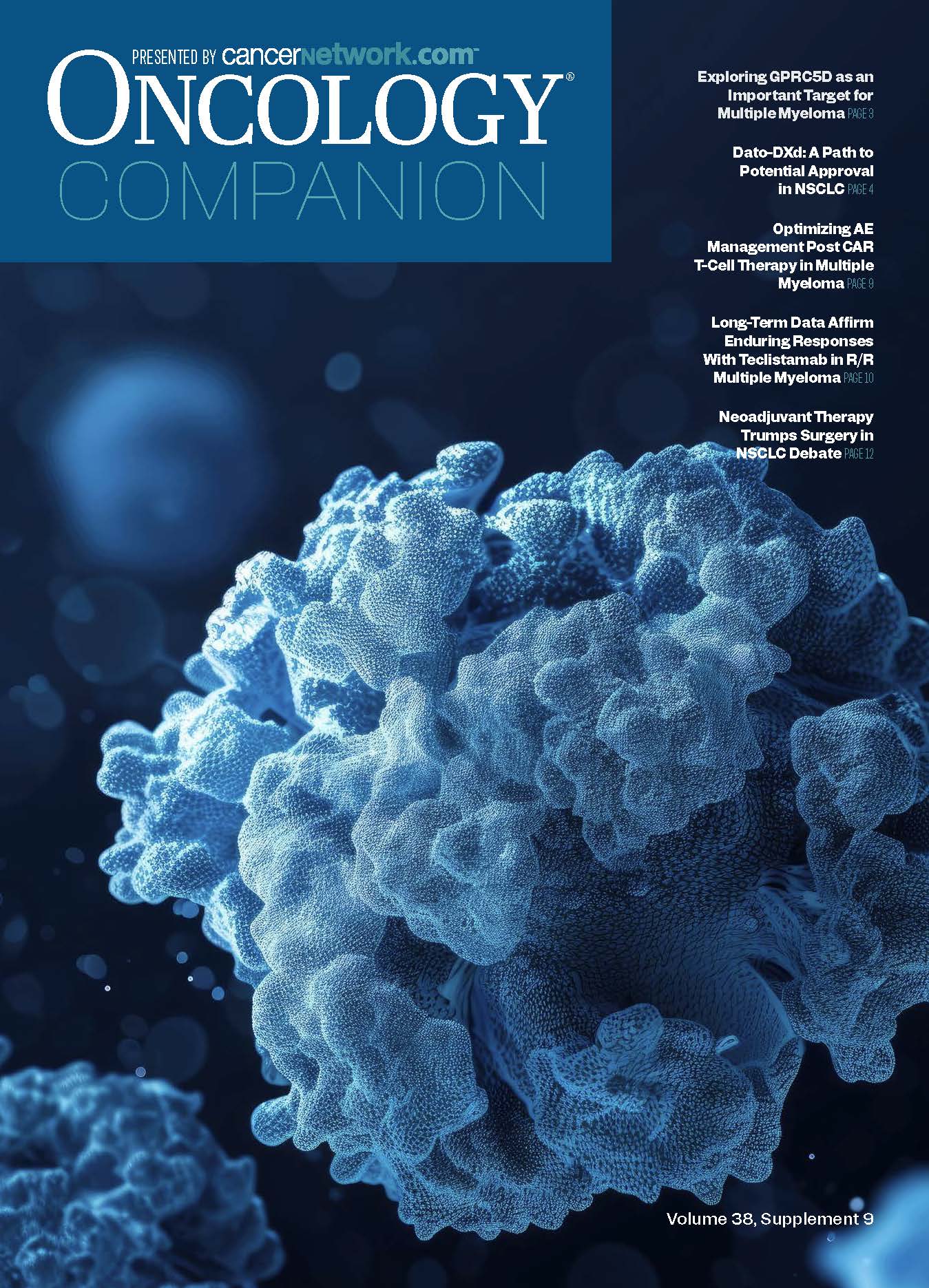Optimizing AE Management Post CAR T-Cell Therapy in Multiple Myeloma
Experts spoke about the best practices for mitigating adverse effects associated with CAR T-cell therapy in relapsed/refractory multiple myeloma.
Meet the experts

In a recent Training Academy segment hosted by CancerNetwork, a panel of experts spoke about the best practices for mitigating adverse effects (AEs) associated with chimeric antigen receptor (CAR) T-cell therapy in relapsed/refractory multiple myeloma. They reviewed clinical trial data to better understand the incidence and severity of toxicities such as cytokine release syndrome (CRS) and immune effector cell–associated neurotoxicity syndrome (ICANS) before discussing multidisciplinary approaches to improving patient outcomes.
Here are their key takeaways:
AE Management Challenges and Infection Mitigation
- Monitoring patients requires coordination within academic centers and collaboration with community oncologists.
- Patients and caregivers should be educated on long-term AEs, such as peripheral neuropathy and movement disorders. Transporting patients from the community to a treatment center is another challenge.
- Extensive documentation can help manage infection risks post CAR T-cell therapy.
- Practices can review vaccines and immunizations required within a year of therapy.
ICANS Incidence and Management
- ICANS or neurotoxicity incidence appears to be similar with different therapies.
- Neurotoxicity occurred in 15% of the KarMMA-3 population.
- Neurotoxic events affected 20.5% of those in CARDITUDE-4.
- It may be advisable for patients to avoid driving for 60 days following CAR T-cell therapy due to potential neurotoxicity.
- Long-term symptoms such as cranial nerve VI or VII palsy may occur.
- Patients should be referred to neurology if these events take place.
Multidisciplinary Strategies and Developing Areas
- Interdepartmental collaboration can bolster supportive care and toxicity management.
- Social workers, pharmacists, apheresis teams, and others may assist with facilitating CAR T-cell therapy.
- Early referrals are critical for assessing high-risk diseases in patients who may be candidates for CAR T-cell therapy.
- Adapting treatment strategies for patients depending on the extent of their prior therapy is an ongoing consideration.
- Long-term AE risks may be different for heavily pretreated patients vs those with only 1 prior line of therapy.
CRS Incidence and Management
- COVID-19 and respiratory infections may be a reference point when explaining the mechanism of CRS to patients.
- The median time to onset and median duration were 1 day and
3.5 days, respectively, with idecabtagene vicleucel (Abecma) in the phase 3 KarMMa-3 trial (NCT03651128).1 - The median time to onset and median duration were 8 days and 3 days, respectively, with ciltacabtagene autoleucel (Carvykti) in the phase 3 CARTITUDE-4 trial (NCT04181827).2
- The median time to onset and median duration were 1 day and
- Despite a lack of definitive data, steroids may help manage low-grade CRS.
- Individualized bridging therapy may offset CRS symptoms and decrease tumor burden.
- Triplet therapy, including proteasome inhibitors and immunomodulatory agents, may be suitable.
References
- Rodriguez-Otero P, Ailawadhi S, Arnulf B, et al. Ide-cel or standard regimens in relapsed and refractory multiple myeloma. N Engl J Med. 2023;388(11):1002-1014. doi:10.1056/NEJMoa2213614
- San-Miguel J, Dhakal B, Yong K, et al. Cilta-cel or standard care in lenalidomide-refractory multiple myeloma. N Engl J Med. 2023;389(4):335-347. doi:10.1056/NEJMoa2303379
EP: 1.Reviewing the Approval Process of Teclistamab in Multiple Myeloma
EP: 2.Multiple Myeloma and ALL Experts Face Off in Data Analyzing Cilta-Cel and Ponatinib Hydrochloride
EP: 3.ASH 2023: The Most Relevant Multiple Myeloma Data Presented
EP: 4.ODAC Casts 11 to 0 Vote in Favor of Cilta-Cel in R/R Multiple Myeloma
EP: 5.Ide-Cel Receives Favorable ODAC Vote for R/R Multiple Myeloma
EP: 6.FDA Approves Ide-Cel in Previously Treated Multiple Myeloma
EP: 7.FDA Approves Cilta-Cel for Relapsed/Refractory Myeloma After 1 Therapy
EP: 8.Managing Cranial Nerve Impairment in Multiple Myeloma Following Cilta-cel
EP: 9.APPs Focus on Education of Talquetamab Use and Administration in Multiple Myeloma
EP: 10.Belantamab Mafodotin Combo Shows PFS Improvement in R/R Multiple Myeloma
EP: 11.Daratumumab Retreatment Yields Sustained Response in R/R Multiple Myeloma
EP: 12.Step-Up Teclistamab Dosing Produces Responses in R/R Multiple Myeloma
EP: 13.Building On Outcomes With Isatuximab in Newly Diagnosed Myeloma
EP: 14.Continued Success of Venetoclax in t(11;14) Multiple Myeloma Despite Negative Trials
EP: 15.Leveraging CAR T-Cell Therapy Advancements in R/R Multiple Myeloma
EP: 16.FDA Approves Subcutaneous Daratumumab Regimen in Newly Diagnosed Multiple Myeloma
EP: 17.Bispecific Antibodies Are Taking the Multiple Myeloma World by Storm
EP: 18.MRD May Predict Improved Outcomes in Multiple Myeloma
EP: 19.Evaluating the Use of CAR T-Cell Therapy for Multiple Myeloma in Academic and Community Settings
EP: 20.Linvoseltamab Still Efficacious Despite CRL in Multiple Myeloma
EP: 21.Exploring GPRC5D as an Important Target for Multiple Myeloma
EP: 22.Long-Term Data Affirm Enduring Responses With Teclistamab in R/R Multiple Myeloma
EP: 23.Determining Administration of BCMA, T-Cell Engagers in R/R Multiple Myeloma
EP: 24.Optimizing AE Management Post CAR T-Cell Therapy in Multiple Myeloma
EP: 25.Assessing NP Roles in Talquetamab Treatment for Multiple Myeloma
EP: 26.Daratumumab Combo Yields MRD-Negative Status in Transplant-Ineligible NDMM
EP: 27.Mitigating Adverse Effects Following GPRC5DTargeted Therapy in Multiple Myeloma
EP: 28.Managing Toxicities Following BCMA-Directed Immunotherapy for Myeloma
EP: 29.Using Real-World Data to Form GPRC5D Therapy Strategies in R/R Multiple Myeloma
EP: 30.Optimal Sequencing Between CAR T and Bispecifics in Multiple Myeloma
EP: 31.Multiple Myeloma Experts Face Off on Sequencing Therapy Options
EP: 32.D-VRd Regimen Sustains MRD Response In Newly Diagnosed Multiple Myeloma Subgroup
EP: 33.Maintenance Teclistamab Yields Preliminary Activity in NDMM
EP: 34.General Lifestyle Recommendations for Receiving Talquetamab in Multiple Myeloma
EP: 35.Belantamab Mafodotin Regimen Improves OS in R/R Multiple Myeloma
EP: 36.Overall MRD Negativity Rates Improved with Cilta-cel vs SOC in MM
EP: 37.Fostering Academic, Community Practice Collaboration for Bispecific Therapy in Multiple Myeloma
EP: 38.Experts Discuss Choosing Bispecifics and Sequencing Options in Multiple Myeloma
EP: 39.CAR T-Cell Therapy Is a Desirable Option in Second-Line Multiple Myeloma
EP: 40.Appropriately De-Escalating Talquetamab to Monthly Dosing in Multiple Myeloma

Fostering Academic, Community Practice Collaboration for Bispecific Therapy in Multiple Myeloma
December 26th 2024Experts in multiple myeloma spoke about optimal treatment strategies for patients who receive bispecific therapy, focusing specifically on facilitating a multifaceted approach between academic and community practices.